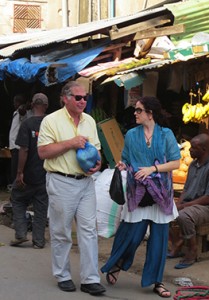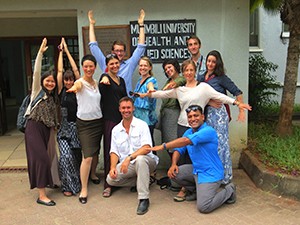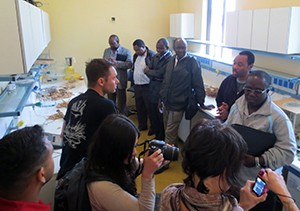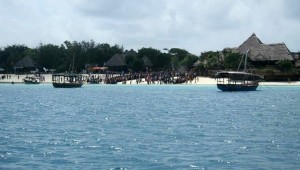I’m back in Tanzania, one of my favorite places on the planet. While I usually get to Africa, and fall into the rhythms of this part of the planet, that has not happened yet on this trip. It’s been a whirlwind so far. In my ideal world, I would have come to Tanzania a few days before my 12 students – to adjust to the time zone, prepare for the trip, and get myself grounded. This year, most of my students arrived a few days before me. I landed with two students and another faculty member at 11 p.m. on Monday and got through customs and back to the hotel at 3 a.m. Tuesday morning, and began teaching by 9 a.m. Tuesday morning. It’s been non-stop ever since. So I apologize for not writing more often. It looks like that will be the case for this trip. Traveling with 12 students is significantly more difficult than traveling with 2, like last year. And for as much as I’d like to share, I simply don’t have time to get my thoughts on paper.
 So how do I have time right now, you may ask? We ran out of rooms at the neighborhood beach hotel we reserved for the students last night. We forgot to count the drivers in the number of rooms, and forgot that Dr. Miller needed his own room. So the drivers and I were exiled to find rooms in Tanga – a community north of Dar. I was excited to find a gem of a room at $15.60 a night – but no clock. Corey (one of the other faculty) had set the alarm on a phone and she gave it to me to use to wake me up. Unfortunately, although the alarm was set for 7 a.m., the time on the phone was never set. So it went off at 3 a.m. Nevertheless, I was thrilled to get 4 hours of sleep in a row. It’s the first time since sometime last week that that has happened.
So how do I have time right now, you may ask? We ran out of rooms at the neighborhood beach hotel we reserved for the students last night. We forgot to count the drivers in the number of rooms, and forgot that Dr. Miller needed his own room. So the drivers and I were exiled to find rooms in Tanga – a community north of Dar. I was excited to find a gem of a room at $15.60 a night – but no clock. Corey (one of the other faculty) had set the alarm on a phone and she gave it to me to use to wake me up. Unfortunately, although the alarm was set for 7 a.m., the time on the phone was never set. So it went off at 3 a.m. Nevertheless, I was thrilled to get 4 hours of sleep in a row. It’s the first time since sometime last week that that has happened.
When we arrived, Obama was in Tanzania. He arrived the same day – but I bet he didn’t have to negotiate getting a Tanzanian visa. Visas are $100, and you get them at the airport in Dar Es Salaam. Obtaining a visa in Tanzania is comical. If you hadn’t just spent 24-36 hours in transit, you might get irritated. But most people are so tired (and relieved to no longer be crushed into a tiny airplane seat) that they just laugh at the ridiculousness of the process.
Here’s how it works. You fill out two forms that are nearly identical to each other. Then you get into a line to hand your application to the guard. He takes them in a particular order (form 1, form 2, passport, $100), though there is no directions in any language anywhere that say that this is the proper order. If you don’t hand your documents to the guard in that order, he pushes you off to the side until the other people have gone through the line. So if you’re smart, you get back in line, and you follow the order of the people in front of you, hoping the guard doesn’t notice that you were one of the people he shoved aside. Once he has your documents, he passes them into an office. This is where there are 3 people who are glassed off in a bank teller-ish office processing applications. You, in the meantime, are pushed into a holding section with the other 200+ people from your flight to stand and wait for your visa.
 In the visa office, the staff randomly pick up passports and forms from the stack, and develop the visa documents. If you thought there was a rhyme or reason to when you stood in the first line, don’t be fooled. This staff could put a random number generator to shame – it’s completely chaotic. Then they call your name (or at least how they THINK your name should be pronounced) and hold your passport (picture page exposed) up to the window. From the front of the holding section, other passengers from the plane call out their interpretation of the name they think the visa officer called, and try to pick you out of the group based on whether you look white or black, blonde or not blonde, male or female. For example, the passengers thought my passport was done when the visa officers called Maria Santorina (from Spain) because we were both blonde females, and by the time the name Santoria reached where I was standing, it sounded a bit like Zwickey. When I got to the front to claim my passport, I realized that it wasn’t me. I memorized the picture, and then I went back through the crowd and attempted to locate Maria. When I found her, she claimed her passport. And then the next name is called. As you can tell, it’s a very efficient process. I’m thinking of using it as an icebreaker for my next immunology class.
In the visa office, the staff randomly pick up passports and forms from the stack, and develop the visa documents. If you thought there was a rhyme or reason to when you stood in the first line, don’t be fooled. This staff could put a random number generator to shame – it’s completely chaotic. Then they call your name (or at least how they THINK your name should be pronounced) and hold your passport (picture page exposed) up to the window. From the front of the holding section, other passengers from the plane call out their interpretation of the name they think the visa officer called, and try to pick you out of the group based on whether you look white or black, blonde or not blonde, male or female. For example, the passengers thought my passport was done when the visa officers called Maria Santorina (from Spain) because we were both blonde females, and by the time the name Santoria reached where I was standing, it sounded a bit like Zwickey. When I got to the front to claim my passport, I realized that it wasn’t me. I memorized the picture, and then I went back through the crowd and attempted to locate Maria. When I found her, she claimed her passport. And then the next name is called. As you can tell, it’s a very efficient process. I’m thinking of using it as an icebreaker for my next immunology class.
While we were in the visa holding cell, Obama was sleeping in the prime minister’s mansion in downtown Dar. We got to see a lot of Obama. No, we didn’t see him live. There were (and still are) giant Obama heads on every lamppost, huge signs in the keepy-leftys (traffic circles), and headlines on every newspaper. More importantly, as any Tanzanian discovered that we were American, they would grin goofily at us and say, “I love Obama!” which can only be followed with a polite “Asante sana” (Thank you very much). Obama left on Wednesday, and the Tanzanians were equally happy to see him go. While they love Obama, he’s a terrible strain on traffic in Dar. It took Julius (one of our drivers) more than 6 hours to get home – usually a 30 minute drive.
 On Wednesday while Obama was leaving, my students and I were at Muhimbii University in Dar. Muhimbili is the local medical school. Last year, my students loved visiting the herbal medicine lab, and there was equal enthusiasm this year. Our tour guide was a lovely microbiologist named Pax. Pax earned two degrees in Tanzania, and then completed his PhD at the Basel Institute in Switzerland. Like all of the other PhD scientists working at Muhimbili, he’s very well educated, and very loyal to Tanzania.
On Wednesday while Obama was leaving, my students and I were at Muhimbii University in Dar. Muhimbili is the local medical school. Last year, my students loved visiting the herbal medicine lab, and there was equal enthusiasm this year. Our tour guide was a lovely microbiologist named Pax. Pax earned two degrees in Tanzania, and then completed his PhD at the Basel Institute in Switzerland. Like all of the other PhD scientists working at Muhimbili, he’s very well educated, and very loyal to Tanzania.
He explained the Tanzanian strategy for studying the herbs and plants that grow here. They start with ethnobotanists who observe the traditional healers, and question them about which plants they’re using, and what they’re treating. Then they harvest the plant, and document the site around it (what feeder plants are growing the vicinity, whether a cow or goat grazes around there, etc.). When the plant reaches the lab, every part of it is tested for activity – the leaves, the stem, and the root. They’re tested as teas first, then as tincture. They’re also analyzed for contaminants. In addition, they’re tested for activity against mosquito larvae – because discovering a natural pesticide that kills mosquito larvae is a goal of theirs. If everything pans out, they pair up with a medical school in the US or Europe to run clinical trials. We’re hoping to be one of their partners.
 What blew the students away was the small size of the facility. There are two relatively small labs, and this is the only facility doing this type of research in the country. Yet, there are more than 10,000 different plants in Tanzania. And there are an estimated 30,000 traditional healers using plant medicine. The scientists who are working here have identified herbs for treating HIV, cancer, diabetes, malaria, and are now working on epilepsy, and other seizure disorders.
What blew the students away was the small size of the facility. There are two relatively small labs, and this is the only facility doing this type of research in the country. Yet, there are more than 10,000 different plants in Tanzania. And there are an estimated 30,000 traditional healers using plant medicine. The scientists who are working here have identified herbs for treating HIV, cancer, diabetes, malaria, and are now working on epilepsy, and other seizure disorders.
I have three students in this group who would jump at the opportunity to work with the scientists in this facility. They’re experts in botanical medicine, and they could use the help. If you think of a grant that could underwrite the students working here, or know a donor who would want to sponsor students, let me know.
After Muhimbili, the students were hungry, so I thought I’d take them to a little café that I know from previous trips. The café was under renovation, but it was open… I should have known better. Everyone ordered from the ‘gourmet’ menu – things like crab cakes with papaya, mango, and avocado salsa, samosas, actual green salads (very hard to come by here), burgers and fries, etc. They were pretty excited to find this place, until the waiter came back and informed us that they were out of crab cakes. And that the samosas were finished. And there was no salad… or burgers. But they could make French fries. It would take 5 minutes. Thank god my students are flexible. We ordered three plates of fries and were satisfied… until we’d waited for over an hour and there was no food. At that point someone noticed a window in the restroom that looked into a small courtyard. The small courtyard had been turned into a makeshift kitchen. There was one cook in the courtyard slowly peeling potatoes. They came back to the table and informed Maria, Julius, and I who went to investigate. How long until the fries, Maria and I asked? 5 minutes. Mmmhm. That’s what they said an hour ago. Have they started cooking them, we asked. Oh, yes. They were cooking. Julius, wise Julius, then asked if they were in the oil. No, they hadn’t purchased the oil yet. Someone was going to run to the market after the potatoes were peeled.
TIA: This is Africa.
My students have affectionately renamed this restaurant “The Soda Lounge” – because that’s really all they could serve. Someone had noticed that all the tables around us were just eating eggs. Eggs were not even on the menu. TIA.
When we went back to the hotel that evening, we encountered our next adventure. Because of Obama, traffic for the ferry to our hotel was beyond horrendous. We had all of the students divided into three jeeps with a faculty member, a driver, and support person/guard for each jeep. But if stayed in the line of cars to cross the bay, it would take 3 hours or more to cross. It was already 9 p.m., and we were leaving for Tanga at 5 a.m. the next morning. So, we decided to take the students on the ferry as pedestrians. This is where the students got to truly appreciate the mass of humanity that is Dar Es Salaam. Remember, there are roughly 9 million people in Dar. And it looked like a good portion of them wanted to go the same place we did.
 As you may have realized from the airport story,Tanzanians rarely do things in a line, and boarding the ferry is no different. After paying our way into the holding area, we had our group of 16 Americans among the 400+ hundred Tanzanians who were waiting for this ferry. The ferry goes roughly every 15 minutes, and the holding area is always near full. When they open the gates for the ferry, the Tanzanians run en masse. It’s amusing to watch – but this time we had to participate. The students paired up, and merged into the swarm. our tall students, Greg and Crane, were like beacons. We could see their heads above everyone and it told the others which direction to go. We were lucky to have Travis with us. Travis is one of our students who has served in the military. He was an exceptional companion. He brought up the rear, and made sure everyone was safe and accounted for. Travis said that his training as a platoon leader prepared him for Tanzanian ferry experience.
As you may have realized from the airport story,Tanzanians rarely do things in a line, and boarding the ferry is no different. After paying our way into the holding area, we had our group of 16 Americans among the 400+ hundred Tanzanians who were waiting for this ferry. The ferry goes roughly every 15 minutes, and the holding area is always near full. When they open the gates for the ferry, the Tanzanians run en masse. It’s amusing to watch – but this time we had to participate. The students paired up, and merged into the swarm. our tall students, Greg and Crane, were like beacons. We could see their heads above everyone and it told the others which direction to go. We were lucky to have Travis with us. Travis is one of our students who has served in the military. He was an exceptional companion. He brought up the rear, and made sure everyone was safe and accounted for. Travis said that his training as a platoon leader prepared him for Tanzanian ferry experience.
I had my first “Aha!” moment when we were on the ferry. As I watched the students chilling on the top of the ferry waiting to disembark (in an equally chaotic way), I realized that they were working well as a group. They were taking care of each other, watching out for each other, and being flexible with the challenges that were happening. This is going to be a fantastic group of students to work with. We got back to our hotel – the Barracuda Beach Hotel – just in time to pack, sleep for two hours, and hit the road again at 5 a.m. to leave for Tanga.
 The road to Tanga is one of my favorite drives. It’s a 6-7 hour drive, and it’s absolutely gorgeous. The savannah is dotted with baobab trees; there are rolling hills and mountains in the distance. We had 3 trucks, driven by Julius, Sky, and George. Each of the trucks had a different environment. Our truck was the music vehicle. Everyone took turns plugging in their i-pods to speakers that I had brought for Julius last year. We played Johnny Clegg (a south African artist), Kanye West, the Pixies, Frank Sinatra, the Toasters, and Van Morrison. It seemed fitting that a diverse combination of tunes provided the soundtrack to the drive. The other trucks were all about the food, mangoes and avocados in one truck and donuts and ketchup flavored Bugles in the other.
The road to Tanga is one of my favorite drives. It’s a 6-7 hour drive, and it’s absolutely gorgeous. The savannah is dotted with baobab trees; there are rolling hills and mountains in the distance. We had 3 trucks, driven by Julius, Sky, and George. Each of the trucks had a different environment. Our truck was the music vehicle. Everyone took turns plugging in their i-pods to speakers that I had brought for Julius last year. We played Johnny Clegg (a south African artist), Kanye West, the Pixies, Frank Sinatra, the Toasters, and Van Morrison. It seemed fitting that a diverse combination of tunes provided the soundtrack to the drive. The other trucks were all about the food, mangoes and avocados in one truck and donuts and ketchup flavored Bugles in the other.
There were several major accidents along the road. Tanzanians signal an accident ahead by laying branches in the road. The first set of branches marked led around a sharp switchback, and to a jackknifed petroleum truck that covered most of the two lane highway, and teetered on the edge of a steep ravine. The driver of the truck slept in the sunshine off the side of the road, waiting for help. Julius took one look at the jackknifed truck, and how it was perched along the ravine, and started “tsk”-ing. “Tsk, tsk, tsk… it’s very bad. They won’t get it up. The truck will be pushed into the ravine after they siphon the fuel out.” The second accident was equally serious. A container truck had flipped off the side of the road and laid on its side, and the three drivers were napping on it. As a person who has had many accidents, I have to say, I’ve never been relaxed enough afterward to nap on top of my wrecked car. This brings laid-back to a new level.
We’re now in Tanga town, which is 90% Muslim. And Ramadan starts tomorrow. I’ll write a letter from Tanga next. In the meantime, I’ll keep hoping that the internet comes back so I can send this.
Love to all of you!
Heather
